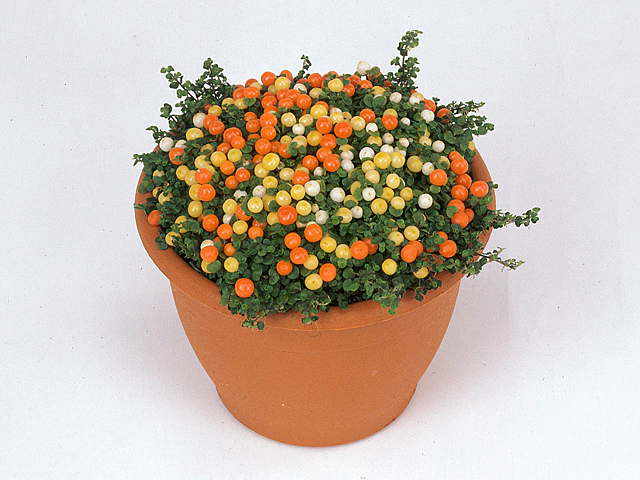Nertera granadensis Minestrone

Nertera granadensis, commonly known as Minestrone or Bead Plant, is a charming little groundcover that is native to New Zealand and certain parts of South America. With its tiny, round leaves and vibrant orange berries, this plant adds a unique and eye-catching touch to any garden or indoor space.
The Minestrone plant is characterized by its trailing stems that can reach up to 12 inches in length. Its small, rounded leaves are bright green in color and are densely packed along the stems, creating a lush carpet-like effect. However, it is the plant's berries that truly steal the show.
The berries of the Nertera granadensis are orange and resemble small, round beads, hence the common name "Bead Plant." These berries begin to form in late summer and are at their most vibrant in the fall. They add a delightful pop of color to the plant and make it a favorite among gardeners looking to add some visual interest to their space.
One of the reasons why the Minestrone plant is so popular is its versatility. It can be grown both indoors and outdoors, making it an excellent choice for those with limited space or for those who want to bring some greenery indoors. When grown as an indoor plant, it is often planted in hanging baskets or small pots, allowing the trailing stems to cascade over the edges, creating a beautiful display.
Outdoors, the Minestrone plant thrives in partial shade or filtered sunlight. It prefers well-draining soil that is kept consistently moist. It is a relatively low-maintenance plant and can tolerate a wide range of temperatures, making it suitable for various climates.
Apart from its visual appeal, the Minestrone plant also has a practical use. Its berries are non-toxic and are perfect for use in floral arrangements or to decorate wreaths and other crafts. They can be dried and used as natural, long-lasting decorations.
Caring for the Minestrone plant is relatively easy. Regular watering is essential to keep the soil moist, but over-watering should be avoided to prevent root rot. Fertilizing with a balanced, water-soluble fertilizer every two weeks during the growing season will help promote healthy growth and berry production.
Propagating the Minestrone plant can be done through stem cuttings, which can be taken and rooted in moist soil or water. These cuttings can quickly establish roots and grow into new plants, allowing gardeners to expand their collection or give them as gifts to fellow plant enthusiasts.
In conclusion, the Nertera granadensis, or Minestrone, is a visually stunning and versatile plant that adds a unique touch to any garden or indoor space. With its trailing stems, dense green foliage, and vibrant orange bead-like berries, it is sure to capture attention and admiration. Whether grown indoors or outdoors, the Minestrone plant is easy to care for and can be enjoyed for its beauty and practicality.
Market availability index by month:
| Jan. | Feb. | Mar. | Apr. | May | Jun. | Jul. | Aug. | Sep. | Oct. | Nov. | Dec. |
|---|---|---|---|---|---|---|---|---|---|---|---|
| 3 | 2 | 3 | 3 | 4 | 3 | 3 | 4 | 4 | 4 | 1 | 2 |